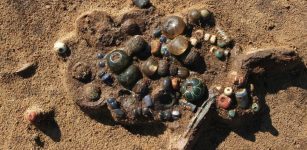Remarkable Neolithic Life-Sized Camel Engravings Discovered In The Nefud Desert
Jan Bartek - AncientPages.com - While investigating a site at the southern edge of the Nefud desert in Saudia Arabia, archaeologists discovered remarkable ancient life-sized engravings of extinct camel species.
The newly discovered rock art site of the Sahout area "is dominated by life-sized, naturalistic, engravings of camels, which are in some cases superimposed with Neolithic imagery of domesticated sheep.
Surveys and test excavations carried out in the vicinity of the rock art revealed a lithic assemblage with similarities to the late Epipalaeolithic and Pre-Pottery Neolithic of the Levant.
Credit: Archaeological Research in Asia (2023). DOI: 10.1016/j.ara.2023.100483
Radiocarbon ages from two test trenches and two hearths indicate repeated occupation at Sahout between the Terminal Pleistocene and the Middle Holocene, which partly mirror the rock art sequence. Investigations at Sahout indicate that rock art production in northern Arabia may have begun earlier than previously thought. Research also suggests a broader geographical extent to human occupations prior to the Holocene humid period," the researchers write in their study published in the journal Archaeological Research in Asia.
Except for ancient rock carvings, there is little archaeological record in northern Arabia pre-dating 6000 B.C. The harsh environment dominated by heat and sand has made it difficult for scientists to investigate the Neolithic era in this part of the world. Most traces of ancient people who lived here have been silently erased, but in recent years, scientists have been able to document "Neolithic sites dating towards the end of the Holocene humid period, ca. 5300–4800 BCE.
This peak in human occupation is primarily visible in the construction of several thousand large-scale stone structures, including mustatils, large rectangular monuments that were used for communal rituals."
"The existence of a rich regional rock art tradition before the arrival of domesticated livestock suggests that a local population was already present in the region. Rare instances of even earlier styles with multiple phases have also been identified in the rock art, including depictions of ‘curvy women’ that are sometimes shown with bird heads, large naturalistic equids, and large naturalistic camels (Guagnin et al., 2017a). However, it is unclear how far back these rock art traditions date," scientists explain in the study.
Ancient camel carvings have previously been found at other sites in Saudi Arabia. "A tradition of large, naturalistic camel engravings has recently been documented across northern Saudi Arabia. This tradition is represented at sites such as the Camel Site in Jawf Province, where life-sized camels were carved in high relief."
While examining the life-sized camel carvings in the Nefud desert, scientists confirmed the engravings made by people living in the area thousands of years ago. The visible differences in technique and style offered evidence the ancient camel engravings were created by different groups of people living during different periods. In addition, the images displayed extinct camel species that scientists knew had once lived in the Arabian Peninsula.
The ancient life-sized carvings appear to have been a communal effort.
"Remarkably, four camel engravings are so similar in their style and carving technique that they were likely carved, re-visited, and re-carved by the same community, following an identical pattern of change and improvement.
See also: More Archaeology News
The locations of these panels, covering a distance of several hundred kilometres, suggest considerable mobility of the engravers and their communities. However, the archaeological context of this wider rock art tradition has not yet been studied and the panels can only be dated through comparative analyses. The cultural and environmental context of this type of engraving therefore remains unknown," the researchers inform.
The study was published in the journal Archaeological Research in Asia
Written by Jan Bartek - AncientPages.com Staff Writer





















